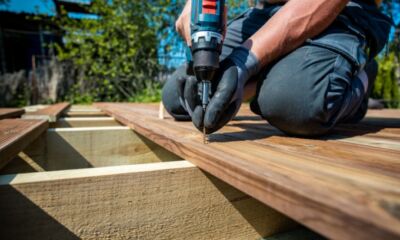How Much Does Decking Cost?
Adding a deck to your home can be an ideal way to enjoy an indoor-outdoor lifestyle. So how much does a deck cost? We take a look at some of the factors that can influence it.

Adding a deck to your home can be an ideal way to enjoy an indoor-outdoor lifestyle. So how much does a deck cost? We take a look at some of the factors that can influence it.
KEY POINTS
- The type of material you use will be a big factor in determining the cost of a new deck.
- Hardwoods like jarrah, spotted gum and merbau are often popular choices for decks.
- Depending on the height off the ground and overall size of your new deck, you may need council approval before building.
In the Australian climate, a deck can be a welcome addition to a home, but if your house doesn’t currently have an outdoor entertaining and living space, you might be thinking about adding one.
As well as the possible lifestyle benefits, building a deck can be a great way to enhance your property, extend your home’s usable floor space, and potentially increase its value. That said, rising labour and material costs paired with supply chain issues means a deck could be somewhat more expensive to build now than in years gone by.
So how much does a deck cost in Australia?
How much does it cost to build a deck?
The cost of a new deck can vary significantly depending on factors including the size of the deck, the material used for flooring, whether it has a roof, the type of balustrade you choose, whether it has any stairs, and site conditions (such as height from the ground, whether the land below the deck is level and the type of soil involved).
Trade jobs listing website hipages says that the cost of a deck can be anywhere between $200 to more than $1,000 per square metre. To give some guidance, hipages breaks the cost down by materials, and estimates the supply and installation costs as follows:
- Treated pine decking: $200 per m²
- Hardwood timber decking: $320 per m²
- Composite decking: $350 per m²
- Elevated cyclone rated decking: $1,000 per m²
Australian timber supplier Austim gives a similar estimate of $160 per m² for basic treated pine decking and over $280 per m² for Australian hardwood timber decking.
How much does it cost to build a deck with a roof?
If your new deck design includes a roof to help protect you from the elements, hipages suggests that the cost of decking with roofing or stairs is around $800 per m².
How your choice of material can impact the cost of a deck
The type of timber you use will likely be a major factor in the cost of your deck. Hardware store chain Bunnings Warehouse says hardwoods such as jarrah, spotted gum and merbau are popular choices for decks, with merbau being the most popular. Other options include treated pine, composite decking, which is made from a mixture of timber fibre and plastic made to look like timber, and modular decking—real timber boards prefabricated into panels for quicker and easier installation.
How does the cost of building a deck break down?
According to Brite Composite Decking Solutions, the most expensive part of building a deck is likely to be the labour involved, with the next-most expensive likely to be the subframe. A deck needs a solid foundation and the subframe, consisting of the wooden or steel beams and posts necessary to hold it up, will be a costly but important part of the installation. They say you can expect the following costs breakdown when building a deck:
- Labour and installation: 45% of overall budget
- Subframe: 30% of overall budget
- Boards: 20% of overall budget
- Fixings and accessories: 5% of overall budget
Do you need building or council approval for a new deck?
Whether or not you’ll need approval from a building certifier or your local council will depend on your location and the specifications of your new deck. While a building certifier can help to ensure your new deck is built safely and meets your aesthetic needs, your local council may have certain restrictions.
As far as the size of your new deck, council approval may be needed for decks larger than 10m² in some areas, while other councils may allow decks up to 25m² before approval is required. Your deck’s height is likely to be an important factor in determining how potentially dangerous it could be. This is why some councils limit deck heights to 600mm off the ground, while others allow for up to 1 metre before approval is required. It can be worth contacting your local council before you begin planning to see what their restrictions are.
What are the options to finance a new deck?
There are many ways to finance a home renovation project, including:
- Savings: Drawing on a savings account means you do not have to take on debt to finance the job, which means you most likely do not have to pay interest or fees on that debt. If you can afford to do so, paying for the job out of your savings will generally save you money in the long run. You can compare savings accounts with Canstar.
- Redraw/offset account on your home loan: You may consider the option of making a redraw on your home loan or using funds saved in your offset account, assuming your home loan has one or both of these features. It’s wise to consider the long-term impact this could have on your mortgage, as paying for a job this way may increase the total amount you have to repay over time when interest is factored in. You can compare home loans with offset accounts with Canstar.
- Personal loan: Depending on your personal circumstances and the cost of the job, you may consider using a personal loan to fund the work. This could come in the form of a secured loan or unsecured loan. It’s worth keeping in mind, though, that interest rates are generally higher for personal loans than for home loans, and it’s a good idea to read the lender’s terms and conditions first. You can compare personal loans with Canstar.
- Credit card: It may also be possible, depending on the cost and your ability to repay the debt quickly, to pay for the job on a credit card. There could be some fringe benefits for doing so, such as extra insurance cover in some cases (read the card’s Key Facts Sheet or the Product Disclosure Statement (PDS) for the insurance cover to find out the conditions of the policy). Keep in mind that credit card interest rates are typically much higher than home or personal loans, and interest can quickly accumulate on large balances, so it’s a good idea to weigh up your options and consider them carefully. If you don’t think you’ll be able to pay off the card’s balance in full each month, it may be worth re-considering whether a credit card is the right option for you. You can compare credit cards with Canstar.
Regardless of which finance option you choose, it could be a wise idea to read your lender’s Target Market Determination (TMD), Product Disclosure Statement (PDS) or other applicable documentation to better understand the terms and conditions you are agreeing to.
-
Additional repayments
-
Redraw facility
-
Top-up facility
-
Application fee: $0
-
Annualised fee: $0
-
Loan terms available: 1 year to 7 years
-
Additional repayments
-
Redraw facility
-
Top-up facility
-
Application fee: $0
-
Annualised fee: $0
-
Loan terms available: 5 years
-
Additional repayments
-
Redraw facility
-
Top-up facility
-
Application fee: $0
-
Annualised fee: $0
-
Loan terms available: 3 years to 7 years
Fast quote. No account required.
Won't affect your credit score. GET YOUR RATE NOW.
-
Additional repayments
-
Redraw facility
-
Top-up facility
-
Application fee: $575
-
Annualised fee: $0
-
Loan terms available: 3 years to 7 years
Canstar may earn a fee for referrals from its website tables, and from Sponsorship or Promotion of certain products. Fees payable by product providers for referrals and Sponsorship or Promotion may vary between providers, website position, and revenue model. Sponsorship or Promotion fees may be higher than referral fees. Sponsored or Promotion products are clearly disclosed as such on website pages. They may appear in a number of areas of the website such as in comparison tables, on hub pages and in articles. Sponsored or Promotion products may be displayed in a fixed position in a table, regardless of the product’s rating, price or other attributes. The table position of a Sponsored or Promoted product does not indicate any ranking or rating by Canstar. For more information please see How We Get Paid.
Additional reporting by Nick Whiting
Cover image source: True Pixel Art/Shutterstock.com
This article was reviewed by our Finance Editor Jessica Pridmore before it was updated, as part of our fact-checking process.

Alasdair Duncan is Canstar's Content Editor, specialising in home loans, property and lifestyle topics. He has written more than 500 articles for Canstar and his work is widely referenced by other publishers and media outlets, including Yahoo Finance, The New Daily, The Motley Fool and Sky News. He has featured as a guest author for property website homely.com.au.
In his more than 15 years working in the media, Alasdair has written for a broad range of publications. Before joining Canstar, he was a News Editor at Pedestrian.TV, part of Australia’s leading youth media group. His work has also appeared on ABC News, Junkee, Rolling Stone, Kotaku, the Sydney Star Observer and The Brag. He has a Bachelor of Laws (Honours) and a Bachelor of Arts with a major in Journalism from the University of Queensland.
When he is not writing about finance for Canstar, Alasdair can probably be found at the beach with his two dogs or listening to podcasts about pop music. You can follow Alasdair on LinkedIn.
The comparison rate for all home loans and loans secured against real property are based on secured credit of $150,000 and a term of 25 years.
^WARNING: This comparison rate is true only for the examples given and may not include all fees and charges. Different terms, fees or other loan amounts might result in a different comparison rate.
 Owner occupied
Owner occupied
 20% min deposit
20% min deposit
 Redraw facility
Redraw facility
Try our Home Loans comparison tool to instantly compare Canstar expert rated options.
The comparison rate for all home loans and loans secured against real property are based on secured credit of $150,000 and a term of 25 years.
^WARNING: This comparison rate is true only for the examples given and may not include all fees and charges. Different terms, fees or other loan amounts might result in a different comparison rate.










